When Loose is a Compliment
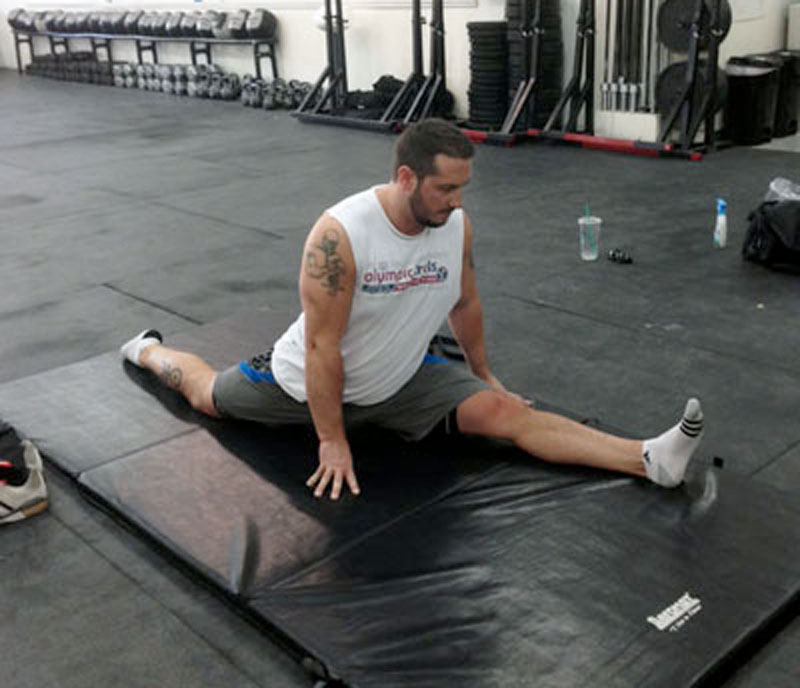
Flexibility is an athletic trait often admired when demonstrated but rarely discussed otherwise. It also seems to be at the center of many arguments, often involving the word Yoga and quickly eliciting facial contortion. Although things seem to be changing lately, historically the topic of stretching has been limited in popular fitness literature to brief mentions rarely progressing beyond the “Just do it” sentiment.
Despite the complexity of the invisible phys¬iology involved, in practical terms, there’s nothing ultimately magical or esoteric about flexibility: it’s simply the product of regular muscle stretching. If you continually pull at the waistband of your underwear, it’ll be¬come increasingly loose until it falls around your ankles (at which time adequate ham¬string and glute flexibility will allow you to reach down and pull it back up). The same idea applies to your muscles.
WHY FLEXIBILITY IS IMPORTANT
First, let’s establish what exactly flexibility is: the degree to which your body is able to reach its full potential range of motion around a particular joint. So why is this im¬portant? Because most of us actually use our bodies in ways that demand motion of some nature, the extent of that motion invariably increasing as we become more athletic. For example, golf requires minimal flexibility, while Olympic weightlifting and gymnas¬tics both require a great deal. (This is not to say, of course, that golfers wouldn’t benefit from increased flexibility).
Simply put, flexibility improves perfor¬mance by allowing the proper execution of movements demanded by our various ath¬letic endeavors. Additionally, in asking our bodies to perform at high intensity, often at their biomechanical limits, the potential for injury is genuine. By increasing the flexibil¬ity of our muscles, we can reduce the strain to tendons and ligaments, avoiding damage that can lead to joint instability and further injury.
HOW STRETCHING WORKS
To accurately understand how stretching works, we need to first understand in at least basic terms muscle composition and the process of muscular contraction.
The largest components of muscles are fas¬cicles, which are visible as muscular stria¬tions in very lean athletes. Fascicles are groups of fasciculi, which are groups of in¬dividual muscle fibers (muscle cells). Fibers are comprised of hundreds of thousands myofibrils, the unit of the muscle that actu¬ally contracts.
Myofibrils are each comprised of approxi¬mately 10,000 sarcomeres end-to-end, each of which is a unit composed of myofilaments along with proteins that act as positional stabilizers and the regulators of filamental interaction.
At the center of each sarcomere are thick filaments, comprised primarily of actin, and thin filaments, comprised of myosin, par¬allel and overlapping from each end. The sliding of the myofilaments along each oth¬er causes the sarcomeres to either shorten or lengthen according to the chemical pro¬cess’s dictation. To conveniently avoid discussing the afore¬mentioned chemistry and distill the physi¬ological process to its essence, muscular contraction begins with the enervation by the nervous system of some number of mo¬tor units (groups of muscle fibers controlled by a single motor neuron). This stimulation initiates a chemical change within the mus¬cle cells, causing the involved sarcomeres to shorten as described above.
A sarcomere either contracts completely or not at all; partial contraction is not pos¬sible. The total force generated by a muscu¬lar contraction, then, is based on the total number of motor units recruited by the ner¬vous system for the movement in question. A contraction typically begins with the re¬cruitment of the smallest and slowest con¬tracting motor units and progresses to the larger and faster ones, allowing smooth, controlled movement.
A peak contraction involves the recruit¬ment of the greatest number of motor units possible. Generally, intense contractions involve what’s called asynchronous motor unit summation: this process is a rotating activation of motor units to provide quickly exhausting units a chance to recover before reactivation. This is what allows the sus¬tainability of intense contractions, although the intensity of any sustained contraction obviously cannot be maximal.
In short, the most important idea to retain here is that a muscular contraction involves only some sarcomeres; some are fully short¬ened while others remain at their normal length. Incidentally, neurological strength gains come from teaching the body to short¬en a larger percentage of sarcomeres in the contracting muscle.
Similarly, increased flexibility is the product of training a larger percentage of muscle fi¬bers to accept increased length. Just as there is no partial contraction of a sarcomere, there is no partial extension of one: the to¬tal distance a muscle can stretch is based on how many sarcomeres are extended.
There are actually two kinds of muscle fi¬bers: extrafusal fibers, which are the ones described above, and intrafusal fibers, com¬monly known as muscle spindles. Intrafusal fibers are proprioceptors: units that detect changes in body position and pressure. The muscle spindles sense both the extent and rate of change in muscle fiber length. Two other muscular proprioceptors are the golgi tendon organ and pacinian corpuscle, both located in tendons.
To protect the body from potential injury due to unsafe stretching of muscles, muscle spindles initiate what’s called the myotat¬ic reflex, the contraction of the stretching muscle. The power of the contraction cor¬responds with the extent and rate of the stretch that instigates it: the faster and more extensive the stretch, the more powerful the resulting contraction (this is the response at play in plyometric training).
When the force of myotatic muscular con¬traction exceeds established limits, the gol¬gi tendon organs initiate the inverse myo¬tatic reflex, also called autogenic inhibition, which overwhelms any myotatic signals and causes the contraction to cease in an effort to prevent injury to muscles, tendons and ligaments.
Essentially, stretching is helping propriocep¬tors become accustomed to positions beyond their present thresholds, therefore allowing a joint a greater range of motion before the initiation of the myotatic reflex. Addition¬ally, holding a stretched position over time will allow autogenic inhibition to occur, which will then allow a greater stretch once muscular contraction has ceased. Stretch¬ing, simply put, is teaching our muscles to be comfortable at a greater length.
TYPES OF FLEXIBILITY
There are two fundamental types of flexibil¬ ity: static and dynamic. As the terms sug¬gest, the former is flexibility in a motionless state, whereas the latter is flexibility involv¬ing motion. Genuine flexibility involves both types, and therefore requires a variety of stretching techniques to achieve.
Following are distilled descriptions of those techniques. Committing these things to memory isn’t requisite to flexibility, but having at least a basic understanding of why you’re doing what you’re doing will help you continue to develop your flexibil¬ity program over time to appropriately suit your personal requirements and goals.
TYPES OF STRETCHING
Ballistic Stretching
Ballistic stretching is what you probably see when you watch your old Jazzercise videos: abrupt, jerky, bouncing movements that use momentum to forcefully push limbs to posi¬tions far past their present limits of range. This type of stretching is generally ill-ad¬vised due to its potential to cause injury and its relatively minimal returns. Chances are that you’ll simply tear muscle tissue, setting your flexibility back even further.
Many athletic movements, of course, inher¬ently and unavoidably involve some degree of ballistic stretching. Caution should be ex¬ercised in these cases: Ensure your muscles are adequately warm—muscles are most flexible at around 1-2 degrees Celsius above baseline body temperature—and stretch thoroughly prior to any potential ballistic activity.
Dynamic Stretching
Like ballistic stretching, dynamic stretching uses motion to move a limb beyond its lim¬its. The critical distinction between the two, however, is the manner in which power is employed and increased range is achieved.
Dynamic stretching uses more controlled, deliberate motion of limbs to move them through a gradually increasing range of motion. This means doing several progres¬sively more extensive repetitions of a move¬ment until the range has eventually peaked. It’s vital to note here the element of control involved in dynamic stretching: while a substantial extension of the present range of motion can be achieved, it’s only reached through gradually increasing power. Each repetition is just powerful enough to ade¬quately progress the limb to the next stage.
Again, to clearly distinguish between ballis¬tic and dynamic stretching, with dynamic there should be a considerable difference in range between the first and last repetitions executed, whereas with ballistic, that final extended range is being attempted immedi¬ately and with every repetition.
One you’ve reached maximum range, typi¬cally at around 8-12 repetitions, stop the movement. Muscles will fatigue with the demands of dynamic stretching, and as they fatigue, their flexibility will progressively decrease. As described earlier, essentially what stretching does is train your body to remember an extended range as being nor¬mal: repetitions following the peak of flexi¬bility will be progressively shorter in range, while at the same time requiring more effort to execute. Your body will remember best what you do most or with the most effort: effectively you’ll overwrite the memories of that earlier maximal range with the shorter one.
Static Stretching
Undoubtedly the most common form of stretching, static stretching involves hold¬ing yourself still in a stretched position for a period of time. The (modified) hurdler’s stretch is an example of a typical static stretch (assuming the subject refrains from bouncing while in it). Static stretching can be achieved using your own strength to hold yourself in position, or employing a partner or any other heavy and/or immobile object willing to cooperate.
Static stretching can be considered both a type of stretching and a category of stretch¬ing inclusive of active, passive, and isomet¬ric stretching, descriptions of which follow.
Active Stretching
Active (AKA static-active) stretching in¬volves slow, deliberate motion to reach a muscle’s limit of range and a static hold at that limit, using nothing more the contrac¬tion of muscles to stretch their antagonists. For example, contracting your hip flexors and quadriceps (agonists) to raise one leg in front of yourself stretches the hamstrings and glutes (antagonists). The contraction of a muscle, through a mechanism known as Reciprocal Inhibition, causes its antagonist to simultaneously relax; in this case, the contractions of the hip flexors and quads cause the glutes and hamstrings to relax, al¬lowing a greater range of motion.
Active stretching is difficult to execute for reasons of balance and agonist muscle strength, but regular active stretching will conveniently enough help improve both of these things along with your flexibility.
Passive Stretching
Passive stretching (AKA static-passive) and static stretching are often considered one and the same and the terms therefore used interchangeably, but technically, passive stretching is a distinct type of stretching ap¬propriately filed in the static category. The distinction between the two is minor and probably ultimately without significant ef¬fect on any of our lives, but we might as well make it while we’re here: The term static stretching appropriately labels any stretch absent of motion, regardless of how that mo¬tionless stretch is held; passive stretching, however, technically involves no effort on the part of the stretcher (e.g. being held in a stretch by someone or something other than your own strength).
Isometric Stretching
Isometric stretching, like passive, can also be filed under the category of static stretch¬ing because of its lack of motion. Isometric stretching simply adds the contraction of the muscle being stretched without allow¬ing the body to move with the contraction (for example, holding a hurdler’s stretch while contracting the hamstrings and glutes as if you were attempting to flex your knee and extend your hip). This contraction ef¬fectively involves more muscle fibers in the stretch, which is why isometric stretching is considered to be one of the fastest routes to increased flexibility.
PNF Stretching
PNF (Proprioceptive Neuromuscular Facili¬tation) stretching is possibly the manner of stretching that will increase your flexibility the quickest. In basic terms, PNF stretching uses your body’s natural mechanical vulner¬abilities to increase the extent to which it will allow a muscle to stretch without acti¬vating a safety response that would impede the stretch. PNF Stretches involve a series of actions for each stretch. Following are two typical PNF stretch techniques.
Contract-Relax: The contract-relax in¬volves entering a static stretch, then isometrically contracting the stretched muscle for 7-15 seconds, relaxing for 2-3 seconds, then repeating the initial static stretch for 10-15 seconds.
Contract-Relax-Antagonist-Contract: My favorite (only partially because of the acronym it creates), the CRAC is per¬formed by isometrically contracting the agonist muscle in the stretch for 7-15 seconds, then contracting the antagonist immediately for 7-15 seconds (e.g., in a hurdler’s stretch, contracting the ham¬strings and glutes, then the quads and hip flexors).
There are some more obscure PNF tech¬niques involving dynamic and even ballistic components, but because of their potential for injury if performed improperly, we’re going to skip those. If you’re interested, find a coach who can guide you through them and closely supervise your technique.
With any PNF stretches, muscles should be allowed about 20 seconds of rest before be¬ing stretched again. Some sources recom¬mend repeating a PNF stretch 3-5 times, while others argue that repetitions beyond one don’t significantly improve results. If you’re short on time, perform one rep of each PNF stretch. Otherwise, I’d recom¬mend experimenting yourself with multiple repetitions: logic seems to dictate that more stretching will produce more flexibility.
PUTTING IT ALL TOGETHER
Now that you have an understanding of the basic physiology behind muscular contrac¬tion and extension, as well as a new collec¬tion of impressive terms like proprioceptive neuromuscular facilitation, how do you ap¬ply this newfound genius and actually in¬crease your flexibility?
When to Stretch
There are two key times when stretching is most beneficial: during the warm-up and cool-down phases of a workout or other ath¬letic activity. Keep in mind, stretching in and of itself is not a warm-up; stretching is merely a component of a warm-up. As the term suggests, the purpose of a warm-up is to actually raise your body temperature ap¬proximately 1 – 2 degrees Celsius. At this temperature, your muscles are at their high¬est potential for flexibility, and your blood circulation and various other processes like synovial fluid secretion in your joints are optimal. Once adequately warmed-up, you can progress from static to dynamic stretch¬ing in order to prepare your body for exer¬tion. Your cool-down stretching should be similar to that in the warm-up, but reversed in order: dynamic stretching first and static second, both following some kind of cool-down activity. Warm-up stretching should be comparatively gentler to your cool-down stretching; the cool-down process is your best opportunity to perform your most in¬tense stretching.
I’d additionally encourage stretching at least once a day regardless of the presence or absence of athletic activity. I’ve found it easiest to stretch every night an hour or two before sleeping. It seems that’s most consis¬tent part of my day, and therefore is very ac¬commodating of routine. Stretching in the morning as well is a good idea, but morning stretching should be much gentler; don’t ex¬pect to be as flexible in the morning as you are at your peak hours of the afternoon.
How Long to Stretch
The duration that stretches should be held is a definite point contention among vari¬ous sources. Recommendations for static stretching range from 15 to 60 seconds. 30 seconds generally seems to be a reasonable duration, but I’d recommend experimenting yourself with shorter and longer durations. For PNF stretches, the contraction phases should be maintained for 7-15 seconds each with 20 seconds of rest between stretches of the same muscles. Experiment with sets of anywhere from 1-5 repetitions. Dynamic stretches should be limited to 8-12 repeti¬tions.
What to Stretch
Following are demonstrations and descrip¬tions of several stretches you can employ in the regular stretching routine I’m confident you’ll establish immediately upon your completion of this article. While this list is not exhaustive—there are a seemingly end¬less number of stretches, each of which has a multitude of variations—it will provide you with more than enough to create a com¬prehensive flexibility program.
CONCLUSION
Flexibility is something that requires work and maintenance, just like everything else related to physical conditioning. That means somehow incorporating a regular stretching routine into your training. You simply can¬not expect any kind of substantial results by haphazardly throwing in a few randomly chosen stretches when you happen to think of it. Develop regularity, and not only will stretching quickly become second nature, but you’ll achieve impressive flexibility in a relatively short period of time.
If you’ve reached this point, you’ve official¬ly invalidated any excuse to not stretch. No more “What about Yoga?” No more “I don’t know how to stretch.” If you value athletic ability, you cannot avoid valuing flexibility: it’s a necessary component of athleticism, not an additional pursuit.
So do it.
.jpg)
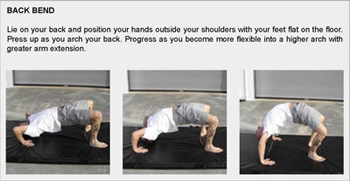

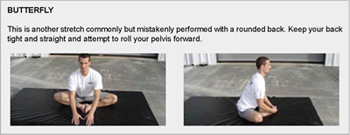
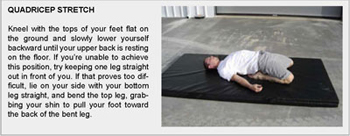
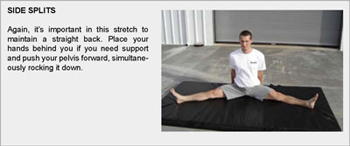
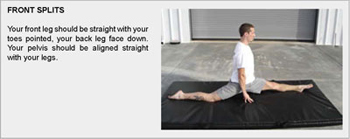
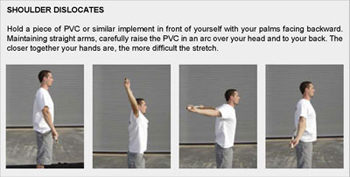
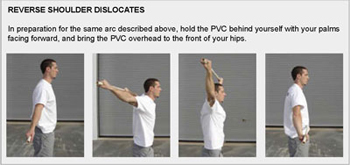
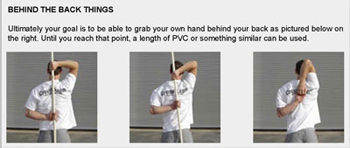
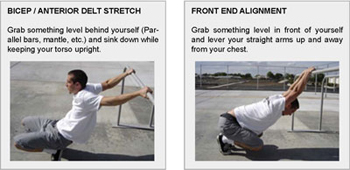
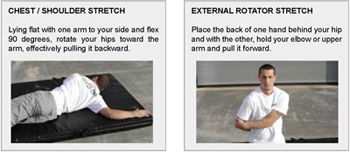
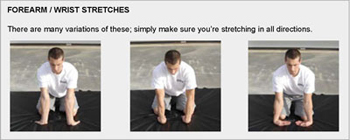
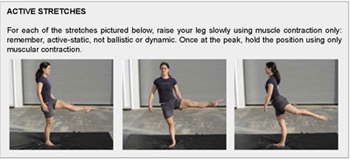
Despite the complexity of the invisible phys¬iology involved, in practical terms, there’s nothing ultimately magical or esoteric about flexibility: it’s simply the product of regular muscle stretching. If you continually pull at the waistband of your underwear, it’ll be¬come increasingly loose until it falls around your ankles (at which time adequate ham¬string and glute flexibility will allow you to reach down and pull it back up). The same idea applies to your muscles.
WHY FLEXIBILITY IS IMPORTANT
First, let’s establish what exactly flexibility is: the degree to which your body is able to reach its full potential range of motion around a particular joint. So why is this im¬portant? Because most of us actually use our bodies in ways that demand motion of some nature, the extent of that motion invariably increasing as we become more athletic. For example, golf requires minimal flexibility, while Olympic weightlifting and gymnas¬tics both require a great deal. (This is not to say, of course, that golfers wouldn’t benefit from increased flexibility).
Simply put, flexibility improves perfor¬mance by allowing the proper execution of movements demanded by our various ath¬letic endeavors. Additionally, in asking our bodies to perform at high intensity, often at their biomechanical limits, the potential for injury is genuine. By increasing the flexibil¬ity of our muscles, we can reduce the strain to tendons and ligaments, avoiding damage that can lead to joint instability and further injury.
HOW STRETCHING WORKS
To accurately understand how stretching works, we need to first understand in at least basic terms muscle composition and the process of muscular contraction.
The largest components of muscles are fas¬cicles, which are visible as muscular stria¬tions in very lean athletes. Fascicles are groups of fasciculi, which are groups of in¬dividual muscle fibers (muscle cells). Fibers are comprised of hundreds of thousands myofibrils, the unit of the muscle that actu¬ally contracts.
Myofibrils are each comprised of approxi¬mately 10,000 sarcomeres end-to-end, each of which is a unit composed of myofilaments along with proteins that act as positional stabilizers and the regulators of filamental interaction.
At the center of each sarcomere are thick filaments, comprised primarily of actin, and thin filaments, comprised of myosin, par¬allel and overlapping from each end. The sliding of the myofilaments along each oth¬er causes the sarcomeres to either shorten or lengthen according to the chemical pro¬cess’s dictation. To conveniently avoid discussing the afore¬mentioned chemistry and distill the physi¬ological process to its essence, muscular contraction begins with the enervation by the nervous system of some number of mo¬tor units (groups of muscle fibers controlled by a single motor neuron). This stimulation initiates a chemical change within the mus¬cle cells, causing the involved sarcomeres to shorten as described above.
A sarcomere either contracts completely or not at all; partial contraction is not pos¬sible. The total force generated by a muscu¬lar contraction, then, is based on the total number of motor units recruited by the ner¬vous system for the movement in question. A contraction typically begins with the re¬cruitment of the smallest and slowest con¬tracting motor units and progresses to the larger and faster ones, allowing smooth, controlled movement.
A peak contraction involves the recruit¬ment of the greatest number of motor units possible. Generally, intense contractions involve what’s called asynchronous motor unit summation: this process is a rotating activation of motor units to provide quickly exhausting units a chance to recover before reactivation. This is what allows the sus¬tainability of intense contractions, although the intensity of any sustained contraction obviously cannot be maximal.
In short, the most important idea to retain here is that a muscular contraction involves only some sarcomeres; some are fully short¬ened while others remain at their normal length. Incidentally, neurological strength gains come from teaching the body to short¬en a larger percentage of sarcomeres in the contracting muscle.
Similarly, increased flexibility is the product of training a larger percentage of muscle fi¬bers to accept increased length. Just as there is no partial contraction of a sarcomere, there is no partial extension of one: the to¬tal distance a muscle can stretch is based on how many sarcomeres are extended.
There are actually two kinds of muscle fi¬bers: extrafusal fibers, which are the ones described above, and intrafusal fibers, com¬monly known as muscle spindles. Intrafusal fibers are proprioceptors: units that detect changes in body position and pressure. The muscle spindles sense both the extent and rate of change in muscle fiber length. Two other muscular proprioceptors are the golgi tendon organ and pacinian corpuscle, both located in tendons.
To protect the body from potential injury due to unsafe stretching of muscles, muscle spindles initiate what’s called the myotat¬ic reflex, the contraction of the stretching muscle. The power of the contraction cor¬responds with the extent and rate of the stretch that instigates it: the faster and more extensive the stretch, the more powerful the resulting contraction (this is the response at play in plyometric training).
When the force of myotatic muscular con¬traction exceeds established limits, the gol¬gi tendon organs initiate the inverse myo¬tatic reflex, also called autogenic inhibition, which overwhelms any myotatic signals and causes the contraction to cease in an effort to prevent injury to muscles, tendons and ligaments.
Essentially, stretching is helping propriocep¬tors become accustomed to positions beyond their present thresholds, therefore allowing a joint a greater range of motion before the initiation of the myotatic reflex. Addition¬ally, holding a stretched position over time will allow autogenic inhibition to occur, which will then allow a greater stretch once muscular contraction has ceased. Stretch¬ing, simply put, is teaching our muscles to be comfortable at a greater length.
TYPES OF FLEXIBILITY
There are two fundamental types of flexibil¬ ity: static and dynamic. As the terms sug¬gest, the former is flexibility in a motionless state, whereas the latter is flexibility involv¬ing motion. Genuine flexibility involves both types, and therefore requires a variety of stretching techniques to achieve.
Following are distilled descriptions of those techniques. Committing these things to memory isn’t requisite to flexibility, but having at least a basic understanding of why you’re doing what you’re doing will help you continue to develop your flexibil¬ity program over time to appropriately suit your personal requirements and goals.
TYPES OF STRETCHING
Ballistic Stretching
Ballistic stretching is what you probably see when you watch your old Jazzercise videos: abrupt, jerky, bouncing movements that use momentum to forcefully push limbs to posi¬tions far past their present limits of range. This type of stretching is generally ill-ad¬vised due to its potential to cause injury and its relatively minimal returns. Chances are that you’ll simply tear muscle tissue, setting your flexibility back even further.
Many athletic movements, of course, inher¬ently and unavoidably involve some degree of ballistic stretching. Caution should be ex¬ercised in these cases: Ensure your muscles are adequately warm—muscles are most flexible at around 1-2 degrees Celsius above baseline body temperature—and stretch thoroughly prior to any potential ballistic activity.
Dynamic Stretching
Like ballistic stretching, dynamic stretching uses motion to move a limb beyond its lim¬its. The critical distinction between the two, however, is the manner in which power is employed and increased range is achieved.
Dynamic stretching uses more controlled, deliberate motion of limbs to move them through a gradually increasing range of motion. This means doing several progres¬sively more extensive repetitions of a move¬ment until the range has eventually peaked. It’s vital to note here the element of control involved in dynamic stretching: while a substantial extension of the present range of motion can be achieved, it’s only reached through gradually increasing power. Each repetition is just powerful enough to ade¬quately progress the limb to the next stage.
Again, to clearly distinguish between ballis¬tic and dynamic stretching, with dynamic there should be a considerable difference in range between the first and last repetitions executed, whereas with ballistic, that final extended range is being attempted immedi¬ately and with every repetition.
One you’ve reached maximum range, typi¬cally at around 8-12 repetitions, stop the movement. Muscles will fatigue with the demands of dynamic stretching, and as they fatigue, their flexibility will progressively decrease. As described earlier, essentially what stretching does is train your body to remember an extended range as being nor¬mal: repetitions following the peak of flexi¬bility will be progressively shorter in range, while at the same time requiring more effort to execute. Your body will remember best what you do most or with the most effort: effectively you’ll overwrite the memories of that earlier maximal range with the shorter one.
Static Stretching
Undoubtedly the most common form of stretching, static stretching involves hold¬ing yourself still in a stretched position for a period of time. The (modified) hurdler’s stretch is an example of a typical static stretch (assuming the subject refrains from bouncing while in it). Static stretching can be achieved using your own strength to hold yourself in position, or employing a partner or any other heavy and/or immobile object willing to cooperate.
Static stretching can be considered both a type of stretching and a category of stretch¬ing inclusive of active, passive, and isomet¬ric stretching, descriptions of which follow.
Active Stretching
Active (AKA static-active) stretching in¬volves slow, deliberate motion to reach a muscle’s limit of range and a static hold at that limit, using nothing more the contrac¬tion of muscles to stretch their antagonists. For example, contracting your hip flexors and quadriceps (agonists) to raise one leg in front of yourself stretches the hamstrings and glutes (antagonists). The contraction of a muscle, through a mechanism known as Reciprocal Inhibition, causes its antagonist to simultaneously relax; in this case, the contractions of the hip flexors and quads cause the glutes and hamstrings to relax, al¬lowing a greater range of motion.
Active stretching is difficult to execute for reasons of balance and agonist muscle strength, but regular active stretching will conveniently enough help improve both of these things along with your flexibility.
Passive Stretching
Passive stretching (AKA static-passive) and static stretching are often considered one and the same and the terms therefore used interchangeably, but technically, passive stretching is a distinct type of stretching ap¬propriately filed in the static category. The distinction between the two is minor and probably ultimately without significant ef¬fect on any of our lives, but we might as well make it while we’re here: The term static stretching appropriately labels any stretch absent of motion, regardless of how that mo¬tionless stretch is held; passive stretching, however, technically involves no effort on the part of the stretcher (e.g. being held in a stretch by someone or something other than your own strength).
Isometric Stretching
Isometric stretching, like passive, can also be filed under the category of static stretch¬ing because of its lack of motion. Isometric stretching simply adds the contraction of the muscle being stretched without allow¬ing the body to move with the contraction (for example, holding a hurdler’s stretch while contracting the hamstrings and glutes as if you were attempting to flex your knee and extend your hip). This contraction ef¬fectively involves more muscle fibers in the stretch, which is why isometric stretching is considered to be one of the fastest routes to increased flexibility.
PNF Stretching
PNF (Proprioceptive Neuromuscular Facili¬tation) stretching is possibly the manner of stretching that will increase your flexibility the quickest. In basic terms, PNF stretching uses your body’s natural mechanical vulner¬abilities to increase the extent to which it will allow a muscle to stretch without acti¬vating a safety response that would impede the stretch. PNF Stretches involve a series of actions for each stretch. Following are two typical PNF stretch techniques.
Contract-Relax: The contract-relax in¬volves entering a static stretch, then isometrically contracting the stretched muscle for 7-15 seconds, relaxing for 2-3 seconds, then repeating the initial static stretch for 10-15 seconds.
Contract-Relax-Antagonist-Contract: My favorite (only partially because of the acronym it creates), the CRAC is per¬formed by isometrically contracting the agonist muscle in the stretch for 7-15 seconds, then contracting the antagonist immediately for 7-15 seconds (e.g., in a hurdler’s stretch, contracting the ham¬strings and glutes, then the quads and hip flexors).
There are some more obscure PNF tech¬niques involving dynamic and even ballistic components, but because of their potential for injury if performed improperly, we’re going to skip those. If you’re interested, find a coach who can guide you through them and closely supervise your technique.
With any PNF stretches, muscles should be allowed about 20 seconds of rest before be¬ing stretched again. Some sources recom¬mend repeating a PNF stretch 3-5 times, while others argue that repetitions beyond one don’t significantly improve results. If you’re short on time, perform one rep of each PNF stretch. Otherwise, I’d recom¬mend experimenting yourself with multiple repetitions: logic seems to dictate that more stretching will produce more flexibility.
PUTTING IT ALL TOGETHER
Now that you have an understanding of the basic physiology behind muscular contrac¬tion and extension, as well as a new collec¬tion of impressive terms like proprioceptive neuromuscular facilitation, how do you ap¬ply this newfound genius and actually in¬crease your flexibility?
When to Stretch
There are two key times when stretching is most beneficial: during the warm-up and cool-down phases of a workout or other ath¬letic activity. Keep in mind, stretching in and of itself is not a warm-up; stretching is merely a component of a warm-up. As the term suggests, the purpose of a warm-up is to actually raise your body temperature ap¬proximately 1 – 2 degrees Celsius. At this temperature, your muscles are at their high¬est potential for flexibility, and your blood circulation and various other processes like synovial fluid secretion in your joints are optimal. Once adequately warmed-up, you can progress from static to dynamic stretch¬ing in order to prepare your body for exer¬tion. Your cool-down stretching should be similar to that in the warm-up, but reversed in order: dynamic stretching first and static second, both following some kind of cool-down activity. Warm-up stretching should be comparatively gentler to your cool-down stretching; the cool-down process is your best opportunity to perform your most in¬tense stretching.
I’d additionally encourage stretching at least once a day regardless of the presence or absence of athletic activity. I’ve found it easiest to stretch every night an hour or two before sleeping. It seems that’s most consis¬tent part of my day, and therefore is very ac¬commodating of routine. Stretching in the morning as well is a good idea, but morning stretching should be much gentler; don’t ex¬pect to be as flexible in the morning as you are at your peak hours of the afternoon.
How Long to Stretch
The duration that stretches should be held is a definite point contention among vari¬ous sources. Recommendations for static stretching range from 15 to 60 seconds. 30 seconds generally seems to be a reasonable duration, but I’d recommend experimenting yourself with shorter and longer durations. For PNF stretches, the contraction phases should be maintained for 7-15 seconds each with 20 seconds of rest between stretches of the same muscles. Experiment with sets of anywhere from 1-5 repetitions. Dynamic stretches should be limited to 8-12 repeti¬tions.
What to Stretch
Following are demonstrations and descrip¬tions of several stretches you can employ in the regular stretching routine I’m confident you’ll establish immediately upon your completion of this article. While this list is not exhaustive—there are a seemingly end¬less number of stretches, each of which has a multitude of variations—it will provide you with more than enough to create a com¬prehensive flexibility program.
CONCLUSION
Flexibility is something that requires work and maintenance, just like everything else related to physical conditioning. That means somehow incorporating a regular stretching routine into your training. You simply can¬not expect any kind of substantial results by haphazardly throwing in a few randomly chosen stretches when you happen to think of it. Develop regularity, and not only will stretching quickly become second nature, but you’ll achieve impressive flexibility in a relatively short period of time.
If you’ve reached this point, you’ve official¬ly invalidated any excuse to not stretch. No more “What about Yoga?” No more “I don’t know how to stretch.” If you value athletic ability, you cannot avoid valuing flexibility: it’s a necessary component of athleticism, not an additional pursuit.
So do it.
.jpg)













| Greg Everett is the owner of Catalyst Athletics, publisher of The Performance Menu Journal and author of Olympic Weightlifting: A Complete Guide for Athletes & Coaches, Olympic Weightlifting for Sports, and The Portable Greg Everett, and is the writer, director, producer, editor, etc of the independent documentary American Weightlifting. Follow him on Facebook here. |
Search Articles
Article Categories
Sort by Author
Sort by Issue & Date
Article Categories
Sort by Author
Sort by Issue & Date

